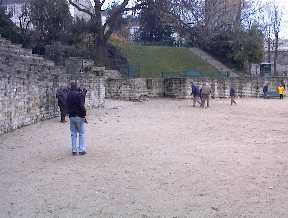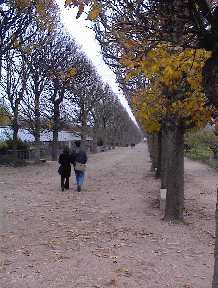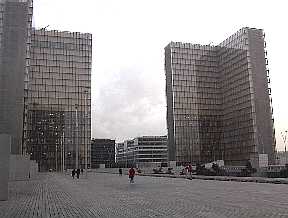 up
the route where we left it at metro station St Placide. We cross Rue de Rennes
and continue into rue Notre-Dame-des-Champs. We then cross Boulevard Raspail and
keep following rue Notre-Dame.
up
the route where we left it at metro station St Placide. We cross Rue de Rennes
and continue into rue Notre-Dame-des-Champs. We then cross Boulevard Raspail and
keep following rue Notre-Dame. Traversée 1 - part 2
... from St Placide through Jardin du Luxembourg, Quatier Latin and La Salpetiere to the National Library (Bibliotheque National)...
We pick  up
the route where we left it at metro station St Placide. We cross Rue de Rennes
and continue into rue Notre-Dame-des-Champs. We then cross Boulevard Raspail and
keep following rue Notre-Dame.
up
the route where we left it at metro station St Placide. We cross Rue de Rennes
and continue into rue Notre-Dame-des-Champs. We then cross Boulevard Raspail and
keep following rue Notre-Dame.
At nr. 53 is "Le Lucernaire", a complex with two cinemas (for art house movies), café's and a restaurant.
We turn left into Rue Vavin and at the end of this nice shopping street we arrive at the Jardin du Luxembourg. We turn left for a bit into rue Guymener and the the garden.
It was Maria de Medici, widow of Henri IV, who ordered the garden and the palace, so that it could remind her of the Pitti Palace and the Gardini di Boboli in her native Florence. In 1564 a house was built on this spot for François of Luxemburg. It is still there and is now known as Petit Luxembourg. In 1612 Maria de Medici bought the house and the grounds and had the Palace and garden laid out in 1615. The Palace is now the seat of the French Senate. The park is the largest green spot on the left bank and open to the public since 1780. It has tennis courts, playgrounds and petanc lawns and a big pond with fountain. In the garden's northeastern corner is the popular Fontaine de Medici from the 17th century.
We leave the Jardin on the Boulevard St Michel, which we cross. Over Place Edmond Rostand we get to Rue Soufflot which leads to the Pantheon, the mausoleum for famous French republicans (see Traversee 2). We turn right into rue LeGoff, and immediately left into Rue Malebranche, that changes into R. des Fossés after crossing Rue St Jacques.
 Rue
St Jacques is the oldest gallo-roman north-south connection in Parijs,
connecting Lutetia (Paris) with Gennabum (Orléans). When we look left we see
the tower of the observory belonging to the Sorbonne University. Note that the
street names are carved into the walls in addition to the painted street signs.
Rue
St Jacques is the oldest gallo-roman north-south connection in Parijs,
connecting Lutetia (Paris) with Gennabum (Orléans). When we look left we see
the tower of the observory belonging to the Sorbonne University. Note that the
street names are carved into the walls in addition to the painted street signs.
On the Place Estrapade we keep left into rue de l'estrapade. We then cross the Rue d'Ulm.
On the corner of rue Clotilde is the lycee Henri IV, taking up a large part of a former monastery of St Genevieve. Here was also the location of a 15th century tower dating back to King Clovis's days (11th century). On number 9 a beautiful house from 1914. The lower level of the courtyard shows the original street level.
Through rue Blainville we get to the lively rue Moufftard (see Traversee 2) and the Place Contrescarpe.
This is a very old crossroad. Once an artistic refuge, where Hemingway sat righting his novels in Café La Chope and Georges Brassens sang his songs.
We continue through rue du Cardinal-Lemoine and turn right into the quiet and charming Rue Rollin.
Number 14 was once home to René Descartes, the philosopher. At numbers 7 and 4 buildings from the 17th century. At the end of the street we go down the stairs and turn left into the Rue Monge and walk down to nr 49.
Behind the gate of nr 49 are the
Arènes de Luttèce, or Lutetia's amphitheatre, Paris' roman predecessor. The  Arènes
date back to the 2nd century were used both as amphitheatre and stage. It could
once hold as many as 15.000 people. It is now the scene of fanatic Petanc games.
Arènes
date back to the 2nd century were used both as amphitheatre and stage. It could
once hold as many as 15.000 people. It is now the scene of fanatic Petanc games.
We take the exit leading towards rue de Navarre. At the end of that street we turn left into rue Lacepede, which, in its turn leads us to the Jardin des Plantes.
The Jardin des Plantes was started in 1626
as a herb garden and gradually develloped into Paris' botanic garden. It has
green houses, leafy lanes, flower beds, lawns and two museums: the Musee
Nationale de l'Histoire Naturelle (rather dull) and the exciting Grand Galerie
de l'Évolution. At various levels the story of the evolution and variety of the
planets wildlife is told with very life like stuffed animals. The lightin g
is impressive and the setup is according to the altitude at which the animals
displayed have their habitat (submarine, surface, mountains, trees and
sky).
g
is impressive and the setup is according to the altitude at which the animals
displayed have their habitat (submarine, surface, mountains, trees and
sky).
We leave the Jardin by the exit on rue Geoffroy. On our right we see the Paris mosque with its square minaret. The complex holds also a hammam, a café and a restaurant.
We turn left and follow rue Geoffroy until rue Polilveau. Here we turn left and continue until the boulevard de l'Hopital. We cross the boulevard and reach the enormous complex of the groupe Hospitaliere de St Pitié-Salpêtière. We enter the hospital grounds through the entry pavilion.
This pavilion dates back to 1767. It leads us into the garden. Construction of the oldest part with its 215m long facade was started in 1660. Louis XIII had designated these grounds as a gun powder plant. Louis XIV changed its designation into a hospital for the poor. Later it also became a psychiatric hospital. Now it is a general hospital. The buildings are dominated by the dome of the Chapelle St Louis. The Chapel is open to visitors and primarily used for concerts.
We enter the chapel through the front entrance and after a visit leave it again at the western exit. We continue over the hospital grounds in a southern direction and leave them at the Boulevard Vincent Auriol. We walk down this boulevard in the direction of the River Seine. At the banks of the Seine we sidestep the route of the Traversee and turn right along the river towards the Bibliotheque National de France (National Library of France).
Bibliotheque Nation ale
de France."François Mitterand" is one of the last "Grands
Projets" launched by François Mitterand during his 14 year tenure as
president. The complex is surrounded by four tower blocks at each corner. From a
distance the seem totally unconnected, but standing on the central deck the lend
the place a sort of enclosed atmosphere with a crater in the middle in which we
find the garden. The architect Domique Perrault unfortunately did not realise
the effect daylight has on printed matter. This is why blinds had to be put in
place behind the windows of the tower, thus losing the original idea of
transparency. All in all it is still a very original concept, best
experienced from the central deck.
ale
de France."François Mitterand" is one of the last "Grands
Projets" launched by François Mitterand during his 14 year tenure as
president. The complex is surrounded by four tower blocks at each corner. From a
distance the seem totally unconnected, but standing on the central deck the lend
the place a sort of enclosed atmosphere with a crater in the middle in which we
find the garden. The architect Domique Perrault unfortunately did not realise
the effect daylight has on printed matter. This is why blinds had to be put in
place behind the windows of the tower, thus losing the original idea of
transparency. All in all it is still a very original concept, best
experienced from the central deck.
Here ends the second part of Traversee 1.
| other travel | ||
| back | continue |